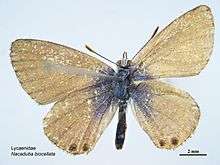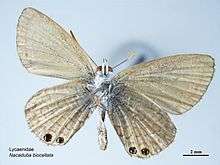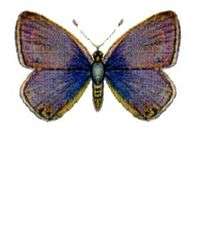Nacaduba biocellata
| Nacaduba biocellata | |
|---|---|
 | |
| Female, dorsal view | |
 | |
| Female, ventral view | |
| Scientific classification | |
| Kingdom: | Animalia |
| Phylum: | Arthropoda |
| Subphylum: | Hexapoda |
| Class: | Insecta |
| Order: | Lepidoptera |
| Family: | Lycaenidae |
| Genus: | Nacaduba |
| Species: | N. biocellata |
| Binomial name | |
| Nacaduba biocellata (C. & R. Felder, [1865])[1] | |
| Synonyms | |
| |
Nacaduba biocellata, the double-spotted line blue, is a butterfly of the Lycaenidae family. It is found in Australia (including New South Wales, the Northern Territory, South Australia, Victoria and Western Australia), Singapore,[2] the New Hebrides, Sumba and Bali.

The wingspan is about 20 mm. Adult females have a brown upperside, while the males are blue with narrow black margins. The underside of both sexes is pale brown with light and dark wavy lines.
The larvae feed on the shoots, flowers and buds of various Acacia species, including A. aneura, A. betchei, A. brachybotrya, A. deanei, A. erinaceae, A. irrorata, A. karroo, A. ligulata, A. osswaldii, A. penninervis, A. rigens, A. salicina, A. sclerophylla, A. sowdenii and A. victoriae. They can have a wide range of colours depending on their host plant, including pink, orange, yellow or green. Their colour appears to depend on the nature of the and buds on which they are feeding. They are attended by ants, mostly Iridomyrmex species, including I. purpureus and I. viridiaeneus.
Pupation takes place in a pale brown pupa, which is formed in debris on the ground under the food plant.
Subspecies
- Nacaduba biocellata biocellata (Australia)
- Nacaduba biocellata armillata (Butler, [1876]) (New Hebrides, Sumba)
- Nacaduba biocellata baliensis Tite, 1963 (Bali)
References
- ↑ Nacaduba at Markku Savela's website on Lepidoptera
- ↑ Australian Insects